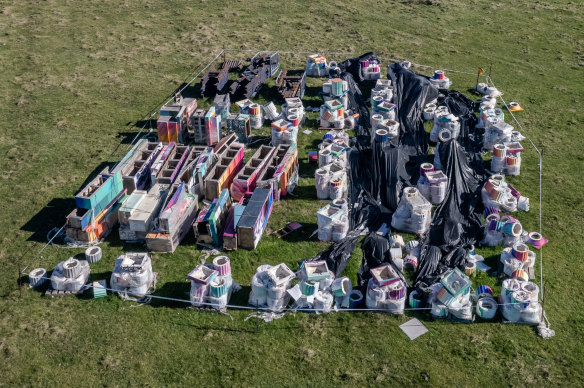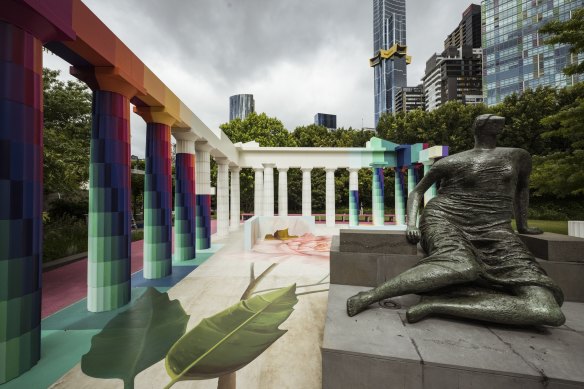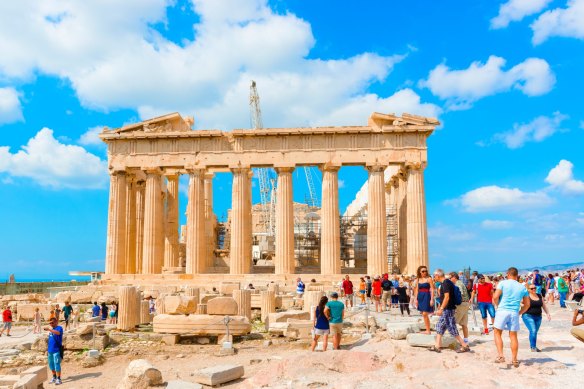By Adam Carey and Elizabeth Flux
The grassy plains west of Epping might be the last place a person would expect to find the ruins of the Parthenon.
But anyone who ventures onto the last remaining cattle grazing paddocks along the busy Craigieburn Bypass has a chance to see the remains of a recent slice of Melbourne art history.
They would need sturdy boots, though, and a willingness to wander well off the trodden path.

An aerial view of the dismantled Temple of Boom in a paddock in Epping.Credit: Jason South
In November 2022, the National Gallery of Victoria revealed the latest winner of its coveted annual Architecture Commission: a large-scale reimagining of the ancient Greek Parthenon, built to roughly one third the size of the original, its lightweight concrete pillars serving as a canvas for several local artists.
The work took pride of place in the St Kilda Road gallery’s garden for nine months, where it was used as a community forum for artistic programs and events. Then it was pulled apart and trucked away to a destination unknown even to its creators.
Melbourne’s major large-scale art installations have had varying fates after finishing their time in official exhibition.

View of the Temple of Boom at NGV in 2022.Credit: Chris Hopkins
Vault was famously shifted from the City Square to a lonely corner on the northern bank of the Yarra River, out of sight of most Melburnians, before eventually being given a more dignified home in Southbank’s arts precinct.
Some iterations of the MPavilion series that takes place across the road from NGV each year have been rehomed in new locations; others are locked away in limbo, waiting like lost dogs for a new owner to love them.
But the Temple of Boom stands alone, in more ways than one, in having been relocated from prime position in Melbourne’s premier gallery to one of the least populated places in the wider city.
The modern reimagining of the Parthenon has been hidden far away from the nearest road, in a rocky paddock that is home to a small herd of cows and many cowpats.
And just like the original, this version of the Parthenon has seen better days.
It has been broken down into hundreds of pieces, loosely stacked, wrapped in stretchy plastic and polystyrene, and roped off behind a buzzing electric wire.
A hiker stumbled upon the dismantled remnants last month while exploring the uninhabited wilds of the Craigieburn Grassland Nature Reserve, alerting The Age to its presence in the mistaken fear that it has been illegally dumped there.
Title deeds indicate the land is privately owned, and is in the early stages of being developed into a large logistics park.

The Parthenon, Acropolis, Athens, Greece.Credit: SHUTTERSTOCK
The NGV had little to say about the work’s current location, but said that its outdoor Architecture Commission series provides opportunities to Australian architects to create a temporary piece of architecture.
“Wherever possible the building materials are designed to be recycled, reused or relocated. The materials are in the process of being moved to a storage location,” the gallery said.
Adam Newman, the Brunswick-based architect behind the project, had expressed hope at the time that his work would find a new home after being decommissioned.
Newman said the drums that form the columns could be “decommissioned and removed relatively simply, and re-erected in another place”.
“We obviously don’t know where that will be, but we are somewhat confident that somewhere in Melbourne or Victoria will be interested in having the Parthenon.”
Newman did not comment about the current status of his artwork but said that “what happens after the commission is very much under the control of NGV”.
Jessie French, a Melbourne-based artist and designer who has worked on the MPavilion series, said the art industry cycles through installations like the retail sector cycles through window displays.
“This is an issue that happens throughout the exhibition and events industry. They’re making these short-term installations, whether it’s a blockbuster gallery show or it’s an architectural folly or pavilion,” French said.
The artist has begun working with algae-based bioplastics to avoid using petrochemicals, inspired by a global movement called the Gallery Climate Coalition, which seeks to reduce consumption in the art industry.
“There is a balance,” French said. “It’s an amazing thing to be able to create something like this that people can experience as an exhibition of architecture, but I think that does need to be questioned particularly as we’re having the coldest winter in so long this year, and we’ve had the hottest day on Earth on record.”
A cultural guide to going out and loving your city. Sign up to our Culture Fix newsletter here.